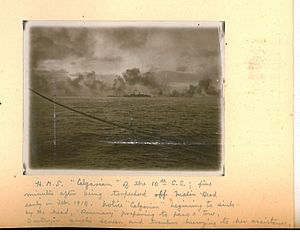HMS Calgarian (1913) facts for kids

SS Calgarian
|
|
Quick facts for kids History |
|
|---|---|
| Name | Calgarian |
| Builder | Fairfield Shipbuilding and Engineering Company Ltd., Glasgow |
| Launched | 19 April 1913 |
| Fate | Sunk 1 March 1918 |
| General characteristics | |
| Tonnage | 17,500 tons |
| Length | 568.8 ft (173.4 m) |
| Beam | 70.3 ft (21.4 m) |
| Draft | 28 feet 6 inches (8.7 m) |
| Depth | 54 feet (16.5 m) molded to the bridge deck |
| Propulsion | 21,000 shp (16,000 kW) turbine engines |
| Speed | 20 knots (37 km/h) |
The SS Calgarian was a large ship used by the Royal Navy during World War I. It was an armed merchant cruiser, which means it was a passenger ship that was also equipped with weapons to help in the war.
On March 1, 1918, the Calgarian was sunk by a German U-boat called U-19. This happened near Rathlin Island in Northern Ireland. The U-boat hit the ship with four torpedoes. The Calgarian sank quickly, and 49 people on board lost their lives.
Contents
Building a Big Ship
The SS Calgarian was built for the Allan Line Royal Mail Steamers. This company ran a main service between Liverpool, England, and Canadian cities like Quebec and Montreal.
Shipyard and Engines
The ship was built by Fairfield Shipbuilding and Engineering Company in Glasgow. It used four special steam engines called Parsons-type steam turbines. These engines helped the ship move through the water.
How Big Was It?
The Calgarian was a very large ship. It was about 590 feet (179.8 m) long. That's longer than two football fields! It was also 70 feet (21.3 m) wide. The ship had eleven watertight sections and a double bottom. This design helped make it safer.
Passenger and Crew Space
The Calgarian could carry many people. It had room for 200 first-class passengers, 500 second-class, and 1,000 third-class passengers. There was also a crew of 500 officers and sailors. The ship had eight decks, named A through H. Passengers stayed on decks A through F.
Special Features
One interesting feature was a small motor launch. This boat could travel at 7 knots (about 13 km/h). It had a radio and was tied to the ship with a long steel wire. This was useful for scouting in foggy weather.
Ship's Speed
The ship's engines were designed to make it travel at 19 knots (about 35 km/h). During tests, the Calgarian actually went even faster. It reached speeds of over 20 knots. This was much faster than what was needed.
Life as a Passenger Ship
The Calgarian began its first journey on May 8, 1914. It sailed from Liverpool to Canada, carrying passengers and mail.
Serving in the War
On September 15, 1914, the Calgarian was taken over by the Royal Navy. It became an armed merchant cruiser. This meant it was used for military tasks.
War Duties
The Calgarian helped block ports like Lisbon and New York. It also carried troops and passengers across the Atlantic Ocean.
Halifax Explosion Help
In December 1917, the Calgarian was in Halifax when a huge explosion happened. The ship's crew helped with rescue efforts. They provided medical aid to those who were hurt.
Change of Ownership
In July 1917, the ship officially became part of Canadian Pacific Railway. However, it continued to serve the Royal Navy until it was sunk.


